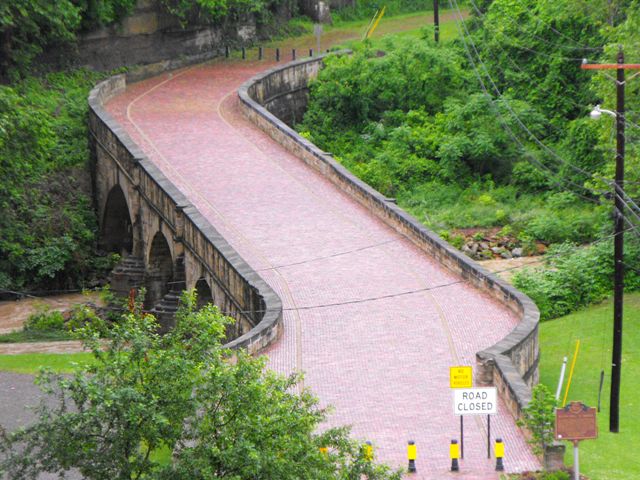We Recommend:
Bach Steel - Experts at historic truss bridge restoration.
Blaine Hill S Bridge
Bicentennial Bridge

Primary Photographer(s): Nathan Holth
Bridge Documented: June 1, 2010
Pasko Drive (Old Historic National Road Alignment) Over Wheeling Creek
Blaine: Belmont County, Ohio: United States
1826 By Builder/Contractor: James Lloyd and Robert Wilson of Hagerstown, Maryland
2004
44.0 Feet (13.4 Meters)
345.0 Feet (105.2 Meters)
27 Feet (8.23 Meters)
3 Main Span(s)
732141

View Information About HSR Ratings
Bridge Documentation
View Archived National Bridge Inventory Report - Has Additional Details and Evaluation
View National Register of Historic Places Nomination Form For This Bridge
This three span stone arch bridge is among the oldest bridges in Ohio with an 1826 construction date. The arch ring of the western span which had severely deteriorated was rebuilt of concrete, and the overall bridge preserved in a noteworthy effort by a local group, the Blaine Bridge Community Preservation Project who was able to save this bridge in the face of demolition plans. As such, this bridge remains standing as the oldest of three generations of roadways following the route of the National Road. The second generation bridge, the high level Blaine Hill Viaduct is also historic and it looms in the background behind this arch bridge forming a unique and beautiful historic scene where two companion historic bridges stand side by side. I-70 is the third generation roadway following the National Road route.
John J. Crnkovich, Ed.D., P.E provided the following additional information which among other things shows that the 1828 construction date is incorrect: I spent two years recording the restoration of the Blaine "S" Bridge.(2003- 2005) My research found that the contract to build the bridge was let in 1825. The contract for the bridge was given to James Lloyd and Robert Wilson of Hagerstown, MD. They were also required to build one mile of road at each end of the bridge, so there could be no argument about the road and bridge meeting properly. In spite of the posted historical marker the bridge was finished in 1826. The bridge was rebuilt during 1915 when the original builder's marker was replaced by a concrete marker which stated the building date was 1826 and that it was rebuilt in 1915. Visited the site September 18, 2010, on the fifth anniversary of the Grand reopening. The bridge is in excellent condition.
Information and Findings From Ohio's Historic Bridge InventorySetting/Context The bridge carries a pedestrian walkway over the stream in a setting of 20th-century residents at the foot of Blaine Hill. The open-spandrel arch bridge carrying US 40 is adjacent. Physical Description The 3 span, stone arch bridge has stone parapets, brick roadway surface, string course, coursed ashlar spandrel walls, and arch rings. The piers have rounded ends that extend upward into shaped, tapered pilasters. Built in 1826, it partially collapsed in 1998. Integrity Following the partial collapse in 1998, the bridge was rehabilitated to the Secretary of Interior's Standards (no adverse effect). Summary of Significance The Blaine "S" Bridge is one of the signature
bridges on the old National Road and was selected as Ohio's Bicentennial
Bridge. It has been rehabilitated without adversely effecting the
significance/integrity. The eligible recommendation of the prior
assessment remains appropriate. Justification The bridge ranks as oldest complete stone arch in the state, and it is a character-defining landmark on the National Road. It is the most historically and technologically example of its type in the state. Information From Previous 2006 Concrete Arch Report This bridge is Ohio' s official Bicentennial Bridge. It is a closed three-span, stone arch bridge built in 1828 and rebuilt in 1916. The bridge partially collapsed in 1998 and was saved from demolition in 1999. Since then the "S" Bridge has undergone major rehabilitation and been restored. The roadway over the bridge is paved in brick and has stone railings. A drainage system to collect runoff from the hill has been added to prevent water from running across the bridge. The bridge is on a 6.3% gradient and has excellent integrity. An Ohio historical marker has been placed at the east end of the bridge. Bridge Considered Historic By Survey: Yes |
![]()
Photo Galleries and Videos: Blaine Hill S Bridge
Bridge Photo-Documentation
Original / Full Size PhotosA collection of overview and detail photos. This gallery offers photos in the highest available resolution and file size in a touch-friendly popup viewer.
Alternatively, Browse Without Using Viewer
![]()
Bridge Photo-Documentation
Mobile Optimized PhotosA collection of overview and detail photos. This gallery features data-friendly, fast-loading photos in a touch-friendly popup viewer.
Alternatively, Browse Without Using Viewer
![]()
Maps and Links: Blaine Hill S Bridge
Coordinates (Latitude, Longitude):
Search For Additional Bridge Listings:
Bridgehunter.com: View listed bridges within 0.5 miles (0.8 kilometers) of this bridge.
Bridgehunter.com: View listed bridges within 10 miles (16 kilometers) of this bridge.
Additional Maps:
Google Streetview (If Available)
GeoHack (Additional Links and Coordinates)
Apple Maps (Via DuckDuckGo Search)
Apple Maps (Apple devices only)
Android: Open Location In Your Map or GPS App
Flickr Gallery (Find Nearby Photos)
Wikimedia Commons (Find Nearby Photos)
Directions Via Sygic For Android
Directions Via Sygic For iOS and Android Dolphin Browser
USGS National Map (United States Only)
Historical USGS Topo Maps (United States Only)
Historic Aerials (United States Only)
CalTopo Maps (United States Only)

